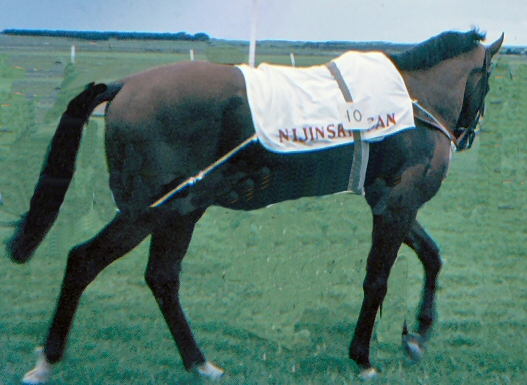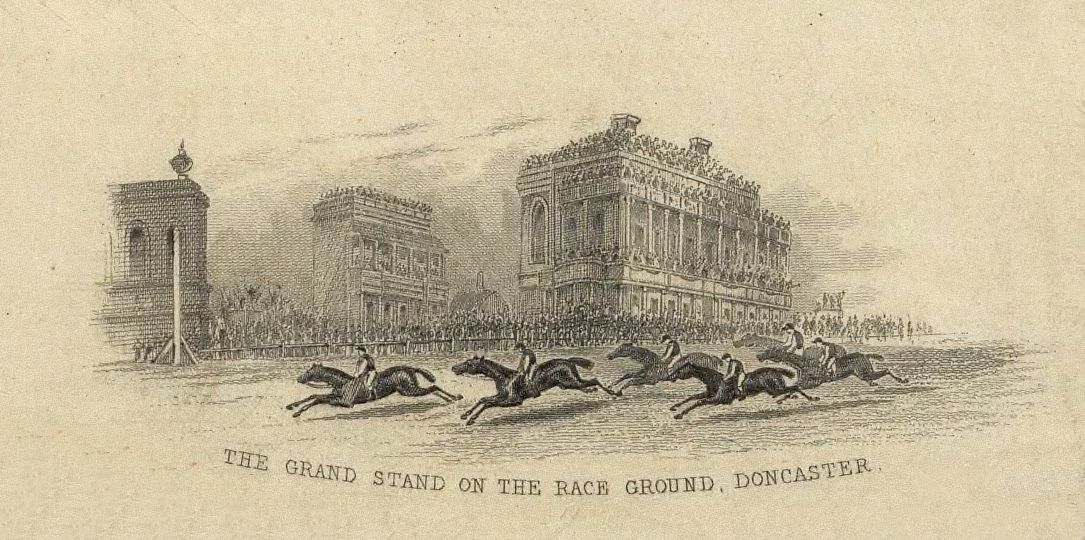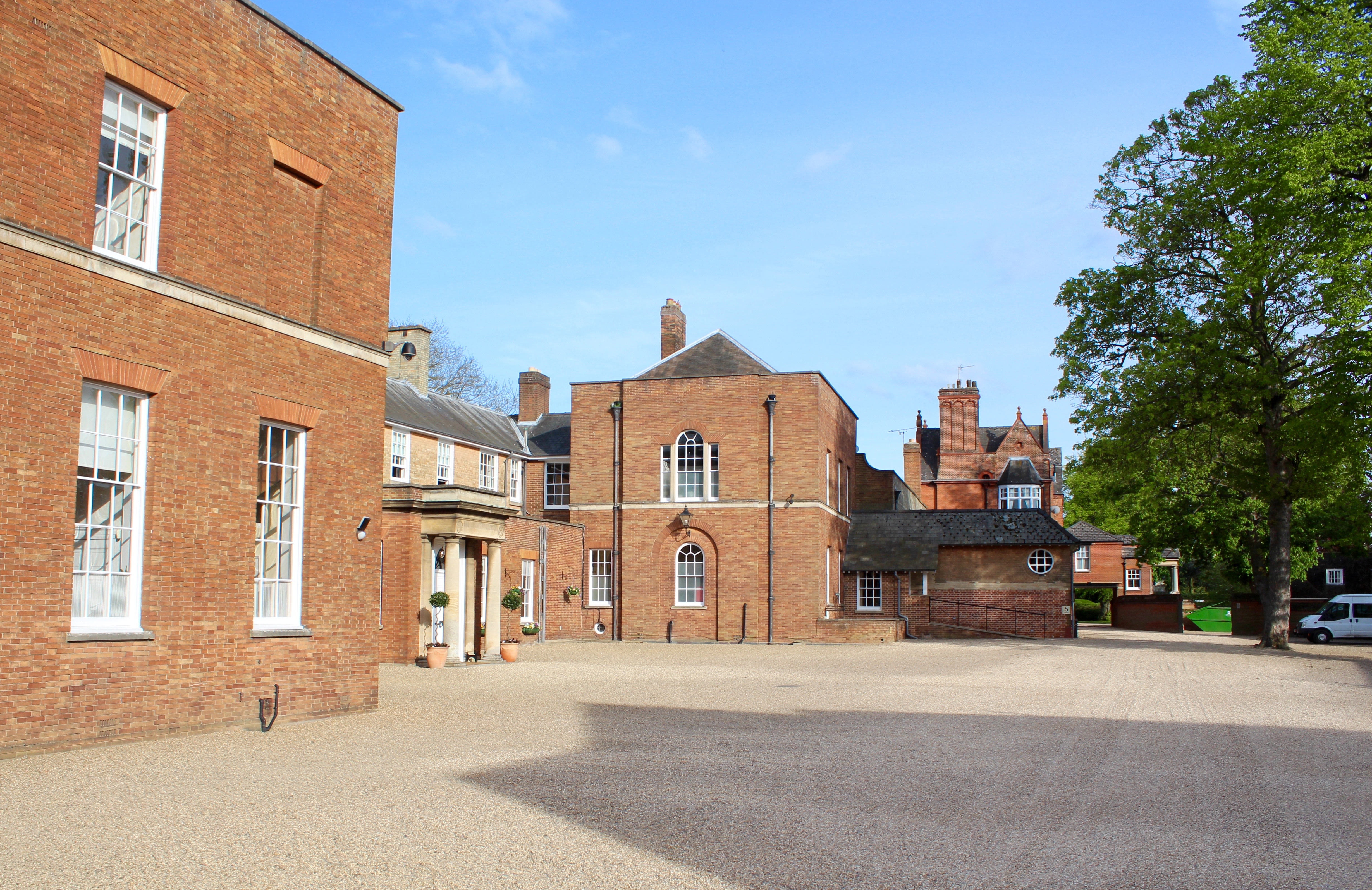|
Mashaallah (horse)
Mashaallah was an American-bred, British-trained Thoroughbred race horse. He is notable for his performances in 1992 when he won Group One races in Italy, Germany and Ireland. Background Mashaallah was bred in Kentucky by William Stamps Farish III. He was sired by the Triple Crown winner Nijinsky out of the Round Table mare Homespun. He was thus a full brother of the Oak Leaf Stakes winner Folk Art and the minor stakes winner Sportin' Life. He is inbred 4x4 to Nearco, meaning that this stallion appears twice in the fourth generation of Mashaallah's pedigree (see below). As a yearling Mashaallah was sold for $525,000 at the 1989 Keeneland July Sale. He was trained throughout his career by John Gosden at Newmarket, Suffolk. His name derives from the Arabic saying Masha'Allah- "whatever God wills". Racing career 1991: three-year-old season Mashaallah was a late-maturing colt who did not appear on the racecourse until June of his three-year-old season, when he ran unplaced in a ... [...More Info...] [...Related Items...] OR: [Wikipedia] [Google] [Baidu] |
Nijinsky II
Nijinsky (21 February 1967 – 15 April 1992) was a Canadian-bred, Irish-trained champion Thoroughbred racehorse and sire. He was the outstanding two-year-old in Europe in 1969 when he was unbeaten in five races. In the following season, he became the first horse for thirty-five years to win the English Triple Crown, a feat that has not been repeated as of 2022. He is regarded as one of the greatest European flat racehorses of the 20th century.“Nijinsky (1970)” Daily Telegraph, 2 June 2018. He was also historically important for establishing t ... [...More Info...] [...Related Items...] OR: [Wikipedia] [Google] [Baidu] |
Nearco
Nearco (January 24, 1935 – June 27, 1957) was an Italian-bred Thoroughbred racehorse described by ''Thoroughbred Heritage'' as "one of the greatest racehorses of the Twentieth Century" and "one of the most important sires of the century." He was unbeaten, winning 14 races at distances from 1000m (5 furlongs) to 3000m (1 mile 7 furlongs), including the Derby Italiano and Grand Prix de Paris. He was then sold for a record amount to Martin H. Benson and stood stud in England, where he became the patriarch of several of the most dominant sire lines in Thoroughbred history. Breeding Nearco was bred in Italy by Federico Tesio, who also bred several other champions including the undefeated Ribot. His dam was the excellent racemare Nogara, who had won the Italian 1000 and 2000 guineas and was Italian champion filly at ages two and three. In 1934, Tesio wished to breed Nogara to the leading English sire Fairway, but was unable to obtain a nomination. Therefore, Tesio chose to breed ... [...More Info...] [...Related Items...] OR: [Wikipedia] [Google] [Baidu] |
Steve Cauthen
Steve Cauthen (born May 1, 1960) is a retired American jockey. In 1977 he became the first jockey to win over $6 million in a year working with agent Lenny Goodman, and in 1978 he became the youngest jockey to win the U. S. Triple Crown. Cauthen is the only jockey ever named ''Sports Illustrated'' Sportsman of the Year. After riding for a few years in the United States, he began racing in Europe. He is the only jockey to have won both the Kentucky Derby and the Epsom Derby. Background Cauthen, the son of a trainer and a farrier, grew up in Walton, Kentucky around horses, which (along with his small size) made race-riding a logical career choice. Racing career North America He rode his first race on May 12, 1976 at Churchill Downs at age 16; he finished last, riding King of Swat. He rode his first winner (Red Pipe) less than a week later, at River Downs.. He was the nation's leader in race wins in 1977 with 487. In only his second year of riding, he becam ... [...More Info...] [...Related Items...] OR: [Wikipedia] [Google] [Baidu] |
Longchamp Racecourse
The Longchamp Racecourse (french: Hippodrome de Longchamp) is a 57 hectare horse-racing facility located on the Route des Tribunes at the Bois de Boulogne in Paris, France. It is used for flat racing and is noted for its variety of interlaced tracks and a famous hill that provides a real challenge to competing thoroughbreds. It has several racetracks varying from 1,000 to 4,000 metres in length, with 46 different starting posts. The course is home to more than half of the group one races held in France, and it has a capacity of 50,000. The highlight of the calendar is the Prix de l'Arc de Triomphe. Held on the first weekend in October, the event attracts the best horses from around the world. History The first race run at Longchamp was on Sunday, April 27, 1857, in front of a massive crowd. The Emperor Napoleon III and his wife Eugénie were present, having sailed down the Seine River on their private yacht to watch the third race. Until 1930, many Parisians came to the track ... [...More Info...] [...Related Items...] OR: [Wikipedia] [Google] [Baidu] |
Newbury Racecourse
Newbury Racecourse is a racecourse and events venue in the civil parish of Greenham, adjoining the town of Newbury in Berkshire, England. It has courses for flat races and over jumps. It hosts one of Great Britain's 36 annual Group 1 flat races, the Lockinge Stakes. History The racecourse held its first race meeting on 26/27 September 1905 at its current location, in the Greenham area on the south-east side of Newbury, West Berkshire. The first recorded racing at Newbury took place in 1805 with "Newbury Races", an annual two-day race meeting at Enborne Heath. The meeting lasted until 1811 when it transferred to Woodhay Heath until 1815. Newbury Racecourse didn't come into existence for another 90 years when Kingsclere trainer, John Porter proposed a new racecourse at Newbury. The Jockey Club had laid down strict qualifications for new racecourses and after Porter's plans were rejected several times, a chance meeting with King Edward VII brought about a further applicati ... [...More Info...] [...Related Items...] OR: [Wikipedia] [Google] [Baidu] |
Newmarket Racecourse
Newmarket Racecourse is a British Thoroughbred horse racing venue in Newmarket, Suffolk, Newmarket, Suffolk, comprising two individual racecourses: the Rowley Mile and the July Course. Newmarket is often referred to as the headquarters of Horse racing in the United Kingdom, British horseracing and is home to the largest cluster of training yards in the country and many key horse racing organisations, including Tattersalls, the National Horseracing Museum and the National Stud. Newmarket hosts two of the country's five British Classic Races, Classic Races – the 1,000 Guineas and 2,000 Guineas, and numerous other Group races. In total, it hosts 9 of British racing's List of British flat horse races#Group 1, 36 annual Group One, Group 1 races. History Racing in Newmarket was recorded in the time of James VI and I, James I. The racecourse itself was founded in 1636. Around 1665, Charles II of England, Charles II inaugurated the Newmarket Town Plate and in 1671 became the fi ... [...More Info...] [...Related Items...] OR: [Wikipedia] [Google] [Baidu] |
Handicap (horse Racing)
A handicap race in horse racing is a race in which horses carry different weights, allocated by the handicapper. A better horse will carry a heavier weight, to give it a disadvantage when racing against slower horses. The skill in betting on a handicap race lies in predicting which horse can overcome its handicap. Although most handicap races are run for older, less valuable horses, this is not true in all cases; some great races are handicaps, such as the Grand National steeplechase in England and the Melbourne Cup in Australia. In the United States over 30 handicap races are classified as Grade I, the top level of the North American grading system. Handicapping in action In a horse handicap race (sometimes called just "handicap"), each horse must carry a specified weight called the impost, assigned by the racing secretary or steward based on factors such as past performances, so as to equalize the chances of the competitors. To supplement the combined weight of jockey and sad ... [...More Info...] [...Related Items...] OR: [Wikipedia] [Google] [Baidu] |
Doncaster Racecourse
Doncaster Racecourse (also known as the Town Moor course) is a racecourse in Doncaster, South Yorkshire, England. It hosts two of Great Britain's 36 annual Group 1 flat races, the St Leger Stakes and the Racing Post Trophy. History Doncaster is one of the oldest (and the largest in physical capacity) established centres for horse racing in Britain, with records of regular race meetings going back to the 16th century. A map of 1595 already shows a racecourse at Town Moor. In 1600 the corporation tried to put an end to the races because of the number of ruffians they attracted, but by 1614 it acknowledged failure and instead marked out a racecourse. Doncaster is home to two of the World's oldest horse races: The Doncaster Cup The earliest important race in Doncaster's history was the Doncaster Gold Cup, first run over Cantley Common in 1766. The Doncaster Cup is the oldest continuing regulated horse race in the world. Together with the Goodwood Cup and Ascot Gold ... [...More Info...] [...Related Items...] OR: [Wikipedia] [Google] [Baidu] |
Sandown Park Racecourse
Sandown Park is a horse racing course and leisure venue in Esher, Surrey, England, located in the outer suburbs of London. It hosts 5 Grade One National Hunt races and one Group 1 flat race, the Eclipse Stakes. It regularly has horse racing during afternoons, evenings and on weekends, and also hosts many non racing events such as trade shows, wedding fairs, toy fairs, car shows and auctions, property shows, concerts, and even some private events. It was requisitioned by the War Department from 1940-1945 for World War II. The venue has hosted bands such as UB40, Madness, Girls Aloud, Spandau Ballet and Simply Red. The racecourse is close to Esher railway station served by trains from London Waterloo. There is a secondary exit from Esher station which is open on race days, this exit leads directly into the racecourse and Lower Green, Esher. History Sandown Park was one of the first courses to charge all for attending. It opened in 1875 and everyone had to pay at least half a ... [...More Info...] [...Related Items...] OR: [Wikipedia] [Google] [Baidu] |
Masha'Allah
''Mashallah'' ( ar, مَا شَاءَ ٱللَّٰهُ, '), also written Masha'Allah, Maşallah (Turkey and Azerbaijan), Masya Allah (Malaysia and Indonesia), Maschallah (Germany), and Mašallah (Bosnia), is an Arabic phrase that is used to express a feeling of awe or beauty regarding an event or person that was just mentioned. It is a common expression used throughout the Muslim world and non-Muslim Arabs to mean, in its literal sense, that “what God has willed has happened”. Etymology The triconsonantal root of ' is šīn-yāʼ-hamza "to will", a doubly- weak root. The literal English translation is "what God has willed",MashAllah meaning Islamic-dictionary.com the of God's will a ... [...More Info...] [...Related Items...] OR: [Wikipedia] [Google] [Baidu] |
Arabic Language
Arabic (, ' ; , ' or ) is a Semitic language spoken primarily across the Arab world.Semitic languages: an international handbook / edited by Stefan Weninger; in collaboration with Geoffrey Khan, Michael P. Streck, Janet C. E.Watson; Walter de Gruyter GmbH & Co. KG, Berlin/Boston, 2011. Having emerged in the 1st century, it is named after the Arab people; the term "Arab" was initially used to describe those living in the Arabian Peninsula, as perceived by geographers from ancient Greece. Since the 7th century, Arabic has been characterized by diglossia, with an opposition between a standard prestige language—i.e., Literary Arabic: Modern Standard Arabic (MSA) or Classical Arabic—and diverse vernacular varieties, which serve as mother tongues. Colloquial dialects vary significantly from MSA, impeding mutual intelligibility. MSA is only acquired through formal education and is not spoken natively. It is the language of literature, official documents, and formal written m ... [...More Info...] [...Related Items...] OR: [Wikipedia] [Google] [Baidu] |
Newmarket, Suffolk
Newmarket is a market town and civil parish in the West Suffolk district of Suffolk, England. Located (14 miles) west of Bury St Edmunds and (14 miles) northeast of Cambridge. It is considered the birthplace and global centre of thoroughbred horse racing. It is a major local business cluster, with annual investment rivalling that of the Cambridge Science Park, the other major cluster in the region. It is the largest racehorse training centre in Britain, the largest racehorse breeding centre in the country, home to most major British horseracing institutions, and a key global centre for horse health. Two Classic races, and an additional three British Champions Series races are held at Newmarket every year. The town has had close royal connections since the time of James I, who built a palace there, and was also a base for Charles I, Charles II, and most monarchs since. Elizabeth II visited the town often to see her horses in training. Newmarket has over fifty horse training stabl ... [...More Info...] [...Related Items...] OR: [Wikipedia] [Google] [Baidu] |


.jpg)




